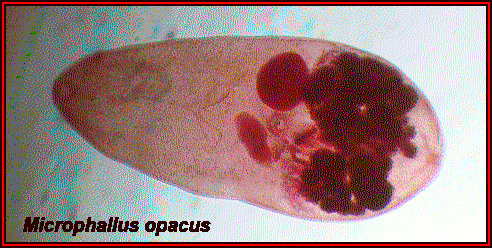The Red Queen: snails and trematodes in New Zealand
Lively, Dybdahl and others have studied the interaction of
parasitism and sexual reproduction extensively in New Zealand
lakes (they started collecting about 15 years ago)
where there are mixed clonal and sexual populations of
New Zealand mud snail,
Potamopyrgus antipodarum.

(oops, this is actually P. potans, a
different species ...original)
which are parasitized by a cestode, Microphallus:

(original)
Details:
- the "parasite harms host" is certainly true, since
parasitic castration is all-or-nothing
- there is genetic (electrophoretic)
variability in hosts
- gene flow of parasites is higher than gene flow
of hosts, which helps the RQ work
Primary theories
A. RESISTANCE TRADEOFFS
Mechanism: tradeoff between competitive ability and resistance to parasites
Predicts:
-
negative correlations between competitive ability OR population prevalence
and parasite load
B. REPRODUCTIVE ASSURANCE:
Mechanism: asexuals ensure reproduction and avoid costs of mating
Predicts:
- asexuals more common at low population densities
- asexuals more common in less stable environments
(more frequent extinction and recolonization)
C. LOTTERY ("hard selection")
Mechanism: sexuals survive in a wider range of (micro)habitats
Predicts:
- asexuals will actually fail to survive alone in some habitats
that are occupied by sexuals
- asexuals more common in environments that are more
variable in time
D. TANGLED BANK
Mechanism: rare offspring of sexuals experience less competition
- sexuals will be more common in environments where
competition is stronger
E. RED QUEEN
Mechanism: sexuals resist parasites better
- sexuals will be more common in environments with more parasites
- time-lagged host-parasite matching: formerly common clones
more susceptible to current parasites
- local adaption: parasites should infect local hosts better
than faraway hosts
-
Lively et al's experiments and observations
- Lively 1987:
- more sexuals in lakes (A2: no, C2: no,
D1: yes, E1: yes)
- sexuals correlated with parasites between lakes (E1: yes)
- Lively 1989: parasites infect local hosts better, regardless
of distance (E3: yes)
- Lively 1992:
- no correlation between pop. density and sexuality
(B1: no)
- Jokela and Lively 1995:
- sexuals correlated with parasites within lakes
(E1: yes)
- Dybdahl and Lively 1995:
- time-lagged association between parasites
and common clones in different lakes (E2: yes)
- Dybdahl and Lively 1998:
- association between parasites and previously common
clones (E2: yes)
- Dybdahl and Lively 2000:
- association between parasites and previously common
local hosts, but not previously common non-local
hosts (E3: yes)
Potential problems for the Red Queen
- RQ may not work without strong parasite effects on host fitness
- can sexuals compete against a diverse set of clones?
- is a tiny bit of sex enough to maintain variation without
losing the advantages of asexuality?
- why do we see so much obligate sexuality/outcrossing?
Other theories
Muller's ratchet plus the Red Queen
Mechanism: parasites drive population fluctuations
which tend to fix deleterious mutations in asexual lineages
Predicts:
- Frequent parasite-induced population crashes
(removing parasites should remove the crashes)
- Relative fitness of the population should be
higher after crashes
Tangled bank plus the Red Queen: truncation selection
Mechanism: parasite resistance determines competitive
ability
Predicts:
- competitive outcomes (between common and rare clones, or
between sexuals and asexuals) should vary in the presence and absence
of parasites
Tangled bank variant #2
(This is what I was confused about in lecture
on Friday)
Mechanism:
sexual variants do better in competition for variable habitats
- more sexuals in variable environments with
strong competition


